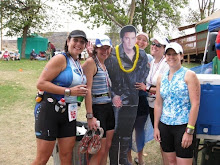Buffalo News
from active.com
The phrase "core strength" is heard often around health clubs these days. Just what is it?
Core strength is not just strong stomach muscles. True core strength is the ability of the "middle" of the body to hold correct posture, maintain balance, have a strong awareness of body and limbs in space and the functional strength to properly use it all.
The muscles of the core and trunk must learn and possess the strength to pull against each other, creating a strong and stable base. This base allows the limbs a stable platform to work from. With a stronger core, the legs and arms and will have more strength and power to perform smoother and with less chance of injury.
The absence of this core strength is the precursor to the increasing number and severity of "non-contact" knee and shoulder injuries. In order to obtain this functional core/trunk strength you must first train movements, then add strength. If too much weight is applied early, the motions are learned and strengthened incorrectly.
Training is the process of teaching the muscles and groups of muscles to be bio-mechanically correct in their motions. Then slowly strengthen the muscles and the movements together, allowing and enhancing proper movements.
Core Exercises
Two good exercise examples for strengthening the core are "Chops" and "Lunges." Chops mimic the actions of chopping wood. When performing Chops, keep the chest up and knees slightly bent, chop to the right left and center.Lunges are performed with the chest and upper torso upright. Step comfortably forward with one leg and bend the knees. The back knee will continue to flex and move straight down until just above the floor. Stop and recover if the torso begins to flex forward. Keep the effort distributed mostly on the back half of the front foot.
Keeping the chest up is critical to bring in the core/trunk muscles to train their correct involvement.
Progression
The process is initiated by using body weight or less to begin the training. Examples are squatting with only a stick on the shoulders or using a leg press machine to push less than your own body weight. Next some light implements such as the medicine ball, light bars and dumb bells can be used.
When movements and muscle comfort are good, a balance component will be increased, not the weight. This makes the body include the very important joint stabilizing muscles, mimicking sports activities.
The last aspect is to significantly strengthen the muscle movements and keep the muscles being used in the lifting activity. By incorporating and combining many movements together in lifting patterns, larger weights or more complicated positions can be used because the entire body is being called on to work.
These higher level lifts are called multi-joint lifts. These sequenced, patterned lifts keep the core strong, the body functionally strong and safer in activities.
Suggested Routine
Here is a suggested routine to begin to trigger functional core/trunk strength gains:
Using the two exercises explained earlier start with one set of five to seven reps. You can progress and increase the difficulty, safely and effectively in one of four ways. Never change more than one factor at the same time:
1. Increase the number of reps in your set (stop at 15).
2. Increase the number of sets (stop at four).
3. Exercise on a softer surface such as an exercise mat.
4. Add weight to hold in your hands, very small weight -- one pound to three pounds -- and add very slowly.
The program should be done every other day. Always check with your doctor before starting any exercise program.
Ed Fitzsimmons is functional conditioning specialist with the University at Buffalo Athletics-Sports Performance. E-mail fitness questions to m_adesso@hotmail.com.





















No comments:
Post a Comment